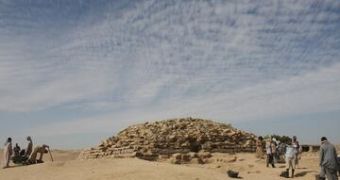Speaking at a recent meeting of the Society for the Study of Egyptian Antiquities held in Toronto, Canada, a team of archaeologists announced that a step pyramid estimated to have been built some 4,600 years ago had been unearthed in Egypt.
The construction, which appears to be have been around for a few decades longer than the Great Pyramid of Giza has, used to measure about 13 meters (42.65 feet) in height at the time when it was completed.
In time, however, many of the blocks that workers used to erect it have been stolen. The result is that the pyramid is now just one third its original size, RT reports.
Despite the fact that the construction's walls are inscribed with hieroglyphic graffiti and several child burials have been discovered at its base, archaeologists say that they have not yet been able to determine what purpose this pyramid served.
Thus, it would appear that both the inscriptions, which include images of a book roll, a seated man, a four-legged animal, and a bird, and the burials are mere “accessories.”
More precisely, they were added to the construction long after its builders had finished their work, the same source details.
The step pyramid is believed to have been built under the reign of Pharaoh Huni or Pharaoh Snefru, and abandoned around the same time when Pharaoh Khufu ordered that the Great Pyramid of Giza be erected.
Given the fact that it does not have any chambers inside it, it could not have served as a burial place.
All things considered, it might have been built just so that one pharaoh or another could label it a symbol of their divine powers and have others perceive it as such as well.
Interestingly enough, the scientific community has for some time now been aware of the existence of the remains of this step pyramid in southern Egypt.
However, it was only in 2010 that a team of archaeologists traveled to the area and started excavating it.

 14 DAY TRIAL //
14 DAY TRIAL //